This silent video presents Toronto City Growth 1880 – 2020.
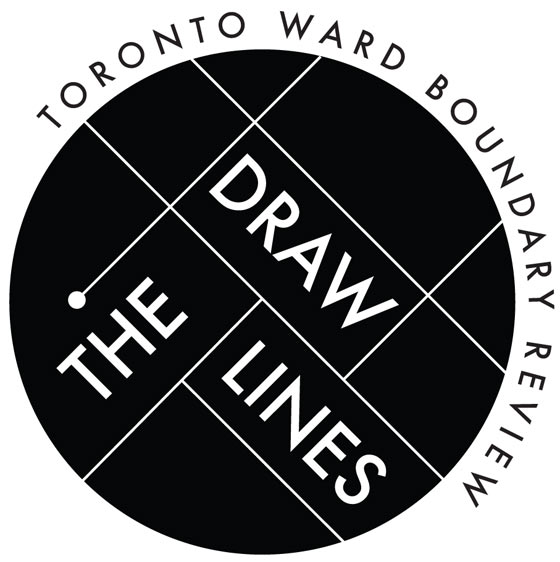
This is an update to the previous blog, You’re Invited: Toronto Ward Boundary Review’s Public Meetings Jan.7, 8, and 10 + Online Survey (Round One).
The Toronto Ward Boundary Review (TWBR) Options Report was recently released this August, outlining five options for new ward boundaries for Toronto.
The Toronto Ward Boundary Review is looking at the size and shape of Toronto’s wards. The Review is being done to ensure each person in Toronto is fairly represented at City Council. A key focus of the Toronto Ward Boundary Review is making sure the number of people in each ward is similar to other wards in the city. This is the most important component of effective representation. The Review will also look at communities of interest and neighbourhoods within the city. Ward boundaries should not split up well-established communities. Other factors such as a ward’s history and physical or natural features will also be considered as part of the review. Read our FAQ…
The study is being done by an independent team of consultants who are responsible for making sure the process is not influenced by political interests.
Reasons for the Review include:
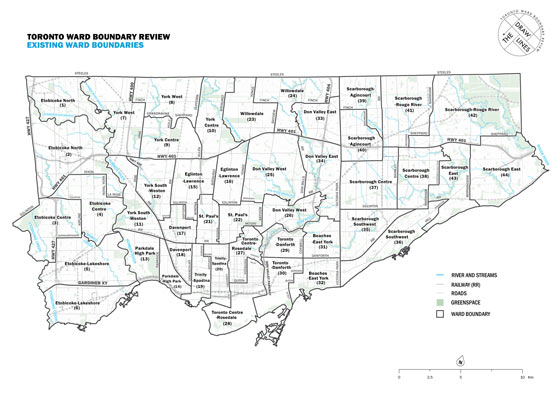
- Currently, in the City of Toronto there is a wide range in the number of people in each ward.
- Due to factors like population growth and new construction, some of the city’s wards are 30 percent to 45 percent above the average population – 61,000.
- As a result, the vote of one person does not have the same value or weight as that of the next person.
- Ward boundary reviews are complex, costly and include extensive public involvement. Municipalities cannot conduct reviews for every election. The TWBR’s goal is to create a ward system that will last for the next four elections – 2018, 2022, 2026 and 2030. To achieve this, the ‘target year’ for effective representation is set at 2026.
The design of the following five options incorporates input received during round one of the TWBR’s civic engagement and public consultation process:
- Option 1: Minimal Change – Average ward size is 61,000
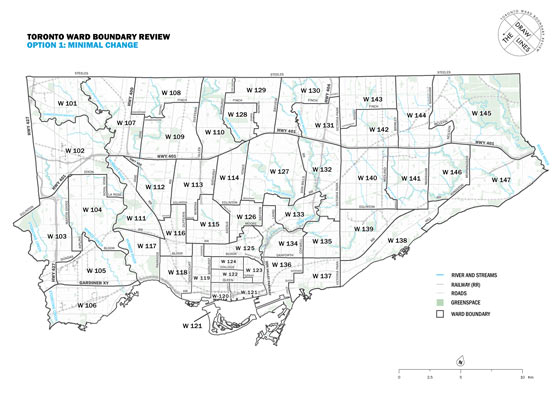
- Option 2: 44 Wards – Average ward population size increases to 70,000
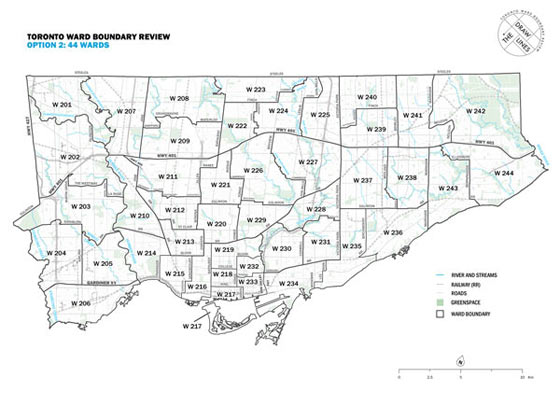
- Option 3: Small Wards – 50,000 Population
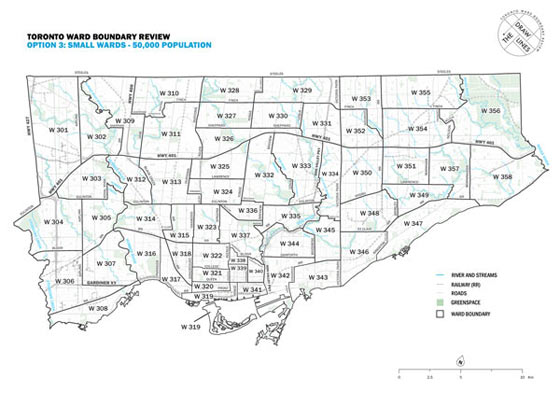
- Option 4: Large Wards – 75,000 Population
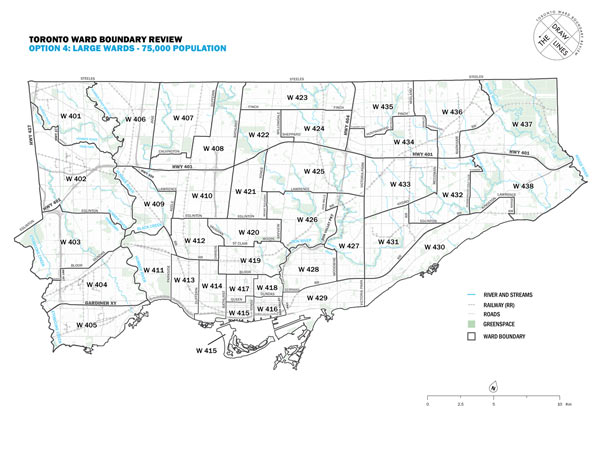
- Option 5: Natural/ Physical Boundaries
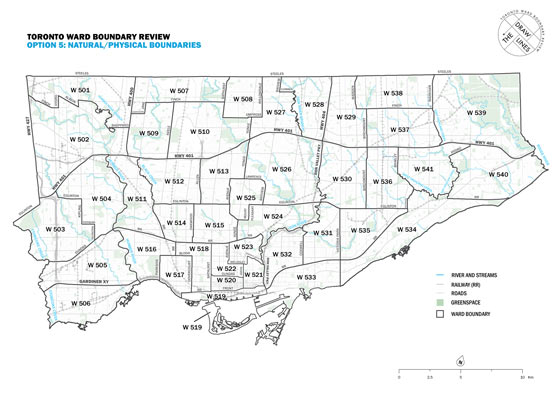
The following timeline of the Toronto Ward Boundary Review is based on a 5-step process:
- Background Research (June 2014 – November 2014)
- Civic Engagement & Public Consultation on Current Ward Boundaries – Round 1 (July 2014 – February 2015)
- Development of Ward Boundary Options (March 2015 – July 2015)
- Civic Engagement & Public Consultation on Ward Boundary Options – Round 2 (August 2015 – November 2015)
- Final Report with Recommendations to Council (May 2016)
Round Two is focused on collecting feedback on 5 options for new ward boundaries in Toronto. There are two ways to provide feedback:
- Complete a Survey. The survey can be completed online or in hard-copy format at http://www.drawthelines.ca/completesurvey
- Attend a Public Meeting. The schedule and info about the twelve public meetings to take place across the city this fall, starting September 16, are available at http://www.drawthelines.ca/publicmeetingdates/ .
Also, the Options Report (August 11, 2015) – pdf, Round One Report – pdf, and Backgroung Research Report – pdf are all available at http://www.drawthelines.ca/reports/ .
Furthermore, you will find the Consultation Guide + Survey for both Round One and Round Two at http://www.drawthelines.ca/guide/ .
Finally, the presentations at the public meeting of Round One and the Executive Committee of the City of Toronto are located at http://www.drawthelines.ca/presentations/ .
NEWS RELEASE
11-Aug-2015
Options for Toronto ward boundaries released today along with invitation for public input
The Toronto Ward Boundary Review (TWBR) Options Report was released today, outlining five options for new ward boundaries for Toronto. The design of the options incorporates input received during round one of the TWBR’s civic engagement and public consultation process. All of the options meet the required criteria for a new ward boundary system.
The purpose of the report is to present options for new ward boundaries for the City of Toronto and receive input from residents, stakeholders and members of Council.
There are two ways to provide input:
1. Complete a survey: The survey can be completed online or in hard-copy format.
2. Attend a public meeting: Twelve public meetings will take place across the city this fall, starting September 16.
The Options Report, as well as information about the survey and the public meetings, can be obtained at drawthelines.ca.
The Options Report and survey are available upon request in the following languages besides English: Chinese (Simple and Traditional versions), Farsi, French, Italian, Portuguese, Russian, Spanish, Tagalog, Tamil and Urdu.
Round two of the TWBR civic engagement and public consultation process is now underway. Input on the options will inform the Final Ward Boundary Review Report, which will include a recommended option and will be presented to the Executive Committee and City Council in May 2016.
About the Toronto Ward Boundary Review
The Toronto Ward Boundary Review is looking at the size and shape of Toronto’s wards in order to ensure that each person in Toronto is fairly represented at City Council.
Toronto’s significant growth has resulted in wards with populations above or below the current average of 61,000, with some wards 30 to 50 per cent above the average. The goal of the Review is to ensure that the population in every ward is similar in size throughout the city.
The City of Toronto has oversight of the Toronto Ward Boundary Review. The study is being done by an independent team of consultants responsible for making sure the process is objective.
The following silent video presents Toronto future skyline 3D model:
Blue = under construction
Yellow = in sales
Red = proposed
——————————————————————
You may also want to know:
- Know The Glow: 4 Tips To Spot The Golden Reflective Glow In A Child’s Photo And Save His or Her Eyes
- Please Urge Ontario to Raise ODSP Rates: Join ‘Stroll & Roll to Freedom’ March on July 7, 2015 UPDATE: Due to unfavourable weather forecast, this event was postponed. The new date of the march will be determined)
- Olympus Europe Invites You: Olympus Photography Playground at No Cost in Munich 25 Aug. – 20 Sept. and Vienna 25 Sept. – 4 Oct. 2015: Borrow the OM-D Camera at No Cost (FREE admission + FREE loan of camera)
- You’re Invited: “Home Field Advantage: Toronto’s Summer Sporting Sites” Exhibition of Historic Photographs Runs to Sept.26 at No Cost: To Celebrate TORONTO 2015 Pan Am/Parapan Am Games July 10 – Aug.14 (FREE Admission for Exhibition)
- Please Help Create the World’s Largest Marine Sanctuary in the Pacific: Petition Before Aug.11, 2014
- McAfee: Superstar Soccer Players’ Screensavers and “Skills” Video Downloads are Risky to Search for Online (McAfee’s FREE SiteAdvisor)
- You’re Invited: Take Home and “Test Drive” a Leica M Camera System & Two Lenses Overnight @ No Cost: Leica Store Bellevue in Washington, USA (FREE Test Drive program)
- Olympus “Test & Wow” Program for the UK: Try Certain Olympus Cameras and Lenses for a Full 24-hour Day at No Cost (Try for FREE)
- Newseum’s ‘Reporting Vietnam’: New Exhibit of Powerful Photos & News Footage for the 50th Anniversary of the Vietnam War: May 22, 2015 – Sept. 12, 2016 (in Washington, D.C., USA; Kids’ Admission is FREE from July 1 to Sept. 7, 2015 )
- You’re Invited: Camera Obscura at The Photographers’ Gallery (FREE admission in London, UK)
- Panasonic + UNESCO: Beautiful 2015 World Heritage Calendar App for PCs & Tablets in Five Languages (FREE App)
- Stratasys’ New Recycling Program of 3D Printing Material Canisters & Cartridges for North American Customers Starts Today: Waste Disposal at No Charge (FREE disposal & recycling program)
- Panasonic Will Share Intellectual Property to Speed Development of Internet of Things (IoT) Software & Services (Panasonic formally pledges to provide royalty-FREE access to software, patents and experience from its product ecosystem)
- Leica: M Magazine App is Available at No Cost & M Magazine No. 2 is Also Available: Dedicated to M Photography Via the Leica M Camera, Presenting Pictures Taken by Renowned Photographers (FREE M Magazine App)
- UrtheCast’s High-Resolution Camera on the ISS Captured & Released the World’s First Full-Color HD Videos of London, Boston and Barcelona from Space (UrtheCast Corp., the Earth Observation (EO) company, aims to open the world to anyone with an internet connection: FREE)
- Photography Copyright Kit (FREE)
- Nikon Canada Invites Canadian Residents to Nikon Image Space: An Online Service for Sharing Photos or Recording Memories (FREE online service for all Canadian residents to share & record images: FREE two GB of storage for everyone and Nikon camera owners get an extra FREE 18 GB of storage.)
- New NIKON IMAGE SPACE App Renewal at No Charge: Benefits Include Seeing Images Larger & Browsing Images Stored on Your Smart Device (FREE online photo sharing service + FREE renewal of smart device app for “NIKON IMAGE SPACE”)
- Canon’s Cloud-based Image Management Service, irista: No Cost for Up to 15GB + New Updates are Now Live (FREE 15GB of cloud storage space with full irista functionality)
- Canon Europe Acquires Lifecake – Baby Photo Timeline: A Photo-sharing App for Families to Create Photo & Video Timelines (Lifecake is available FREE for iPhone, iPad and Android)
- You’re Invited to the New Leica Fotopark: A Photo Platform for Passionate Photographers to Discover, Exchange, Organise, Create [Registration on www.leica-fotopark is FREE, as is the use of the platform for data volumes of up to ten gigabytes (GB)]
- You’re Invited: Download Leica Fotografie International App for iPhone, iPod Touch, iPad and Android
- Scarborough Subway Project Assessment-Line 2 Extension: Public Consultations Jan.31 & Feb.2, 2015 + Online Feedback
- Panasonic’s Medical Delivery Robot “HOSPI” in the “Center for Advanced Medical Robotics” in Thailand
- Celebrate: Fort York Visitor Centre (five new exhibitions inside the new Visitor Centre in 2014 – 2015)
